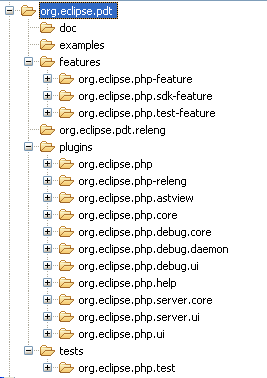Notice: this Wiki will be going read only early in 2024 and edits will no longer be possible. Please see: https://gitlab.eclipse.org/eclipsefdn/helpdesk/-/wikis/Wiki-shutdown-plan for the plan.
PDT/Development Environment
Contents
Understanding the GIT Structure
If you are unfamiliar with GIT and Gerrit concepts, there is a good list of resources on the eclipse contributing page.
Modules structure
There is one module of the Eclipse PDT project in GIT.
| GIT Repository | Directories | |
| /gitroot/tools/org.eclipse.pdt.git | ||
| plugins | contains the PDT plug-ins | |
| features | contains the PDT features | |
| doc | contains the PDT documentation plug-ins and features | |
| tests | contains the PDT automated tests plug-ins and features | |
| examples | contains the PDT examples | |
Build tag and branch naming conventions
The structure of the GIT repository is shown below:
Checking Out Code as an Anonymous User
An anonymous user has access only to check out files from the GIT repository. This user does not have the privileges to check in files.
Configuring the GIT client to check out files
- Open the GIT perspective in the Eclipse Workbench by selecting Windows > Open Perspective > GIT.
- Right click on the GIT Repositories view, and select New > Repository Location...
Clone URI: git clone http://git.eclipse.org/gitroot/pdt/org.eclipse.pdt.git # or if you're eclipse user and/or PDT committer: git clone ssh://committerid@git.eclipse.org:29418/pdt/org.eclipse.pdt.git
Checking Out Code
If you followed the instructions in the previous section, you should see a new repository entry in the GIT Repositories view.
To check out code, you have two options. Either check out the projects automatically using a Team Project Set File, or manually.
Using Team Project Set File (.psf)
- Download the PSF file and save it somewhere memorable, like your desktop.
- Back in Eclipse, switch to the Java perspective.
- From the File menu or Project Explorer context menu, select Import.
- Choose Team > Team Project Set, then click Next.
- Browse for the .psf file you want to use. Click Finish.
- Each feature & plugin will then be checked out as a project in the workspace.

